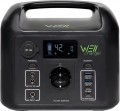UPS function
Charging stations with
UPS function switch consumers to backup power from their own battery, acting as an uninterruptible power supply. In comparison with full-fledged UPSs, switching does not occur instantly, but with a certain delay (about 10-30 ms). To use this function correctly, you must first study the instructions for the charging station, which often describes the correct procedure for connecting the intended consumer devices.
USB A
Full-size USB A connectors are popular in computer technology, they are standardly used in adapter chargers for 230 V household networks and 12 V auto sockets. In charging stations, such outlets are widely used for charging gadgets.
- The total number of such ports can be very diverse (
1 USB,
2 connectors,
3 ports and even
4), since it allows you to connect for charging, and in some cases for power, various low-power devices -
smartphones,
tablets,
power banks,
lamps, etc. .
- The strength of the power. The maximum power output through the USB A connector to the device being charged. Note that different ports of the charging station can output different power (for example, 1.5 A and 2.1 A). In this case, the highest power strength is usually indicated.
— Power. The maximum
output power in watts (W) that the charging station is capable of delivering through the USB A connector to one charging device.
USB A (quick charge)
Full size
USB A ports with fast charging support. It allows you to charge your smartphone, tablet or other connected device much faster. The charging process takes place at increased power, and the current and voltage at each stage are regulated in such a way as to remain within the optimal values. However, it should be borne in mind that in our time there are many fast charging technologies and not all of them are compatible with each other.
- The strength of the current. The parameters of the current issued through the USB A fast charging connectors. Note that different voltage and current parameters can be output to different ports of the charging station. This item specifies the current values at a certain voltage (for example, 5 V / 3 A, 9 V / 2 A, 12 V / 1.5 A).
— Power. The maximum power in watts (W) that the charging station is capable of delivering through the USB A fast charging connector to one charging device. High output power allows you to speed up the charging process. However, the appropriate power must be supported by the device being charged - otherwise the speed of the process will be limited by the characteristics of the gadget.
USB C
USB type C ports are smaller than classic USBs, and they also have a convenient reversible design that allows you to connect the plug in either direction.
USB type C was originally designed to be able to implement various advanced features: increased power supply, fast charging technologies, etc.
Since the port is relatively new and quite powerful (there are
USB type C with a power of 60 W and even
100 W), the total number of such connectors is often limited to
1 port, less often
two).
- The strength of the power. The maximum power output through the USB type C connector to a charging device. Note that different ports of the charging station can output different power (for example, 1.5 A and 2.1 A). In this case, the highest power strength is usually indicated.
— Power. The maximum power in watts (W) that the charging station is capable of delivering to one rechargeable gadget. The high output power of the USB type C port allows you to speed up the charging process. However, the appropriate power must be supported by the device being charged - otherwise the speed of the process will be limited by the characteristics of the gadget.
Car cigarette lighter
Built-in cigarette lighter socket with 12 V output voltage in the design of the charging station. Such an interface is in fact a standard "car socket" used to connect various devices to the car's on-board network. The presence
of a cigarette lighter socket (car outlet) allows you to use the charging station as a power source for such devices. The number of sockets in different models can be different - most often there is one cigarette lighter, but occasionally there are options for a couple of connectors.
DC output
The presence of a DC connector (or several such outputs) in the device to power external gadgets with direct current. The standard DC jack is round and has a pin in the center. However, its dimensions may differ in depth and diameter. The voltage output to the
DC output may be different. The most popular options are 18 - 20 V for powering laptops, 12 V for various specialized devices and automotive electrical accessories.
From solar panels
The ability to charge the device from solar panels ensures the energy independence of a portable power plant. Models with this function can work completely autonomously and do not depend on outlets.
Charging from the panels is implemented in the corresponding devices with portable solar panels and charging stations, which are structurally provided with specialized connectors for receiving power from stationary solar panels, and there is also a built-in MPPT charge controller (Maximum Power Point Tracking).
DC input
DC connector for a distinctive round plug (like those used in many laptops) used to recharge the battery of the device. Note that
DC- in plugs may have different sizes, and chargers with such plugs may have different operating voltages. In practice, this leads to the fact that finding a suitable charger for a portable station is not easy, you need to be especially careful when searching.
Battery type
—
Li-Ion. The key advantage of lithium-ion batteries is their high capacity with small dimensions and weight. Also, Li-Ion batteries are not subject to memory effect and can charge quite quickly. Of course, this option is not without its drawbacks - first of all, it is sensitivity to low or elevated temperatures, and if overloaded, the lithium-ion battery can catch fire or even explode. However, thanks to the use of built-in controllers, the likelihood of such “accidents” is extremely low and, in general, the advantages of this technology significantly outweigh the disadvantages.
—
Li-Pol. An improved version of lithium-ion technology (see the corresponding paragraph): the liquid electrolyte in Li-Pol batteries is replaced with a solid polymer. At the same high capacity, the batteries have become more compact, there is practically no “memory effect” in them, and the likelihood of fires and explosions in the event of critical violations of operating conditions is minimized. The downside of these improvements was increased cost and increased sensitivity to frost. However, most often these shortcomings are not significant.
—
LiFePO4. Lithium iron phosphate batteries are a modification of lithium ion batteries (see corresponding paragraph) designed to eliminate some of the shortcomings of the original technology. LiFePO4 batteries are characterized by a
...large number of charge/discharge cycles, chemical and thermal stability, low temperature tolerance, short charging time (including high currents) and safety in operation. The likelihood of an “explosion” of a LiFePO4 battery when overloaded is reduced to almost zero, and in general, such batteries cope with high peak loads without problems and maintain the operating voltage almost until discharge.
— Li-Ion NMC. A type of lithium rechargeable battery using a complex alloy in the manufacture of the cathode. It contains nickel, manganese and cadmium. This “recipe” allows you to increase the power of a power source based on Li-Ion NMC elements. Batteries of this type have a high specific capacity and a stable discharge voltage, provide a long operating time of the charging station with high performance, are characterized by a complete absence of “memory effect”, maintain functionality over a wide temperature range and are fireproof.
— VRLA. Acid batteries with a regulating safety valve to release excess gas. The abbreviation VRLA stands for Valve Regulated Lead Acid. Batteries of this type have a sealed, non-separable design and come in two types: AGM VRLA (the battery plates are equipped with a layer of fiberglass absorbent) and GEL VRLA (with a gel electrolyte in a jelly-like state). Batteries with a control valve are resistant to deep discharges, do not require topping up with distillate throughout their entire service life, and do not emit hydrogen or oxygen.
- Semi-solid State. An advanced type of lithium-ion battery (see above), which combines some of the characteristics of liquid and solid batteries. It uses an electrolyte that is in a semi-soft or gel-like state, making the batteries more resistant to leakage than traditional wet batteries. Semi-solid state technology allows for a significant increase in the energy density of cells. As a result, it is possible to make compact batteries with high energy intensity.
